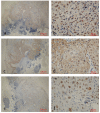HPV58 E7 Protein Expression Profile in Cervical Cancer and CIN with Immunohistochemistry
- PMID: 33613760
- PMCID: PMC7890325
- DOI: 10.7150/jca.50816
HPV58 E7 Protein Expression Profile in Cervical Cancer and CIN with Immunohistochemistry
Abstract
Background: The persistent infection of high-risk human papillomavirus (HR-HPV) is one of the most common causes of cervical cancer worldwide, and HPV type 58 (HPV58) is the third most common HPV type in eastern Asia. The E7 oncoprotein is constitutively expressed in HPV58-associated cervical cancer cells and plays a key role during tumorigenesis. This study aimed to assess the HPV58 E7 protein expression in the tissues of cervical cancer and cervical intraepithelial neoplasia (CIN). Methods: A total of 67 HPV58-positive cervical samples were collected, including 25 cervical cancer samples and 42 CIN samples. All the tissues were examined by HPV58 E7, p16INK4a and Ki67 immunohistochemistry (IHC). At last, we analyzed their association with clinical and pathological variables. Results: HPV58 E7 expression was detected in 96% of the HPV58 DNA-positive cervical cancer tissues and 85.7% of HPV58-positive CIN tissues. 65 samples of cervical cancer and CIN tissues had p16-positive staining, while 59 samples were Ki-67 positive. Conclusions: HPV58 E7 protein is highly expressed in both cervical cancer and CIN tissues. HPV58 E7 IHC could be sensitive and specific for evaluating HPV-driven cervical cancer and pre-cancerous lesions, in combination with p16 and Ki-67 IHC.
Keywords: CIN; E7; HR-HPV; cervical cancer; immunohistochemistry.
© The author(s).
Conflict of interest statement
Competing Interests: The authors have declared that no competing interest exists.
Figures
Similar articles
-
Production of Polyclonal Antibody to the HPV58 E7 Protein and Its Detection in Cervical Cancer.PLoS One. 2016 Dec 29;11(12):e0169138. doi: 10.1371/journal.pone.0169138. eCollection 2016. PLoS One. 2016. PMID: 28033368 Free PMC article.
-
Human Papillomavirus E7 Oncoprotein Promotes Proliferation and Migration through the Transcription Factor E2F1 in Cervical Cancer Cells.Anticancer Agents Med Chem. 2021;21(13):1689-1696. doi: 10.2174/1871520620666201106085227. Anticancer Agents Med Chem. 2021. PMID: 33155930
-
Prediction and identification of human leukocyte antigen-A2-restricted cytotoxic T lymphocyte epitope peptides from the human papillomavirus 58 E7 protein.Oncol Lett. 2018 Aug;16(2):2003-2008. doi: 10.3892/ol.2018.8875. Epub 2018 Jun 1. Oncol Lett. 2018. PMID: 30008894 Free PMC article.
-
Assessment of the association between the frequency of micronucleus and p16INK4a/Ki-67 co-expression in patients with cervical intraepithelial lesions.Biotech Histochem. 2018;93(7):496-504. doi: 10.1080/10520295.2018.1462533. Epub 2018 May 23. Biotech Histochem. 2018. PMID: 29790789
-
Immunohistochemical Evaluation of E6/E7 HPV Oncoproteins Staining in Cervical Cancer.Anticancer Res. 2016 Jun;36(6):3195-8. Anticancer Res. 2016. PMID: 27272848
Cited by
-
Characteristics of Vaginal Microbiome in Reproductive-Age Females with HPV Infection in Xinjiang, China.Evid Based Complement Alternat Med. 2022 Nov 1;2022:7332628. doi: 10.1155/2022/7332628. eCollection 2022. Evid Based Complement Alternat Med. 2022. PMID: 36387363 Free PMC article.
References
-
- Bray F, Ferlay J, Soerjomataram I. et al. Global cancer statistics 2018: GLOBOCAN estimates of incidence and mortality worldwide for 36 cancers in 185 countries. CA Cancer J Clin. 2018;68:394–424. - PubMed
-
- Ding T, Wang X, Ye F. et al. Distribution of human papillomavirus 58 and 52 E6/E7 variants in cervical neoplasia in Chinese women. Gynecol Oncol. 2010;119:436–43. - PubMed
LinkOut - more resources
Full Text Sources
Other Literature Sources



